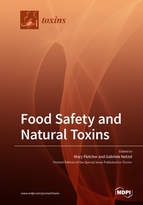Food Safety and Natural Toxins
A special issue of Toxins (ISSN 2072-6651).
Deadline for manuscript submissions: closed (15 May 2019) | Viewed by 38098
Special Issue Editors
Interests: natural toxins; toxin characterization; phytotoxins; analytical methods; toxin degradation; food safety
Special Issues, Collections and Topics in MDPI journals
Special Issue Information
Dear Colleagues,
Natural toxins are poisonous secondary metabolites produced by living organisms, which are typically not harmful to the organisms themselves but can impact on human or animal health when consumed. Common sources of such toxins include poisonous plant, fungi, algae and bacteria, and the diversity of these biological systems presents challenges to analytical chemists and wide-ranging food safety implications when present as contaminants in food commodities. The propensity for such toxins to be present in both animal feed and human food has led to the introduction of regulations for a small number of the most potent natural toxins, particularly mycotoxins and pyrrolizidine alkaloids. Implementation of these regulations necessitates the establishment of high throughput analytical chemistry methods, such as LC-MS and GC-MS, with increasingly lower limits of detection, and the production of isotopically labelled analogues as internal standards to increase the reliability of analysis in complex matrices. Impacts of plant toxins are not limited to grazing livestock but can be carried through the food chain, with some toxins, such as indospicine, being demonstrated to accumulate in tissues of grazing animals and cause secondary poisoning in animals consuming meat from these livestock. Pyrrolizidine alkaloids also have generated significant concern in recent years as potential contaminants in honey through pollen and nectar transfer from flowers into this common food commodity. This Special Issue will focus on analysis of natural toxins, their incidence from source organisms to food and feed commodities, and implications for food safety.
Prof. Mary Fletcher
Dr. Gabi Netzel
Guest Editors
Manuscript Submission Information
Manuscripts should be submitted online at www.mdpi.com by registering and logging in to this website. Once you are registered, click here to go to the submission form. Manuscripts can be submitted until the deadline. All submissions that pass pre-check are peer-reviewed. Accepted papers will be published continuously in the journal (as soon as accepted) and will be listed together on the special issue website. Research articles, review articles as well as short communications are invited. For planned papers, a title and short abstract (about 100 words) can be sent to the Editorial Office for announcement on this website.
Submitted manuscripts should not have been published previously, nor be under consideration for publication elsewhere (except conference proceedings papers). All manuscripts are thoroughly refereed through a double-blind peer-review process. A guide for authors and other relevant information for submission of manuscripts is available on the Instructions for Authors page. Toxins is an international peer-reviewed open access monthly journal published by MDPI.
Please visit the Instructions for Authors page before submitting a manuscript. The Article Processing Charge (APC) for publication in this open access journal is 2700 CHF (Swiss Francs). Submitted papers should be well formatted and use good English. Authors may use MDPI's English editing service prior to publication or during author revisions.
Keywords
- natural toxins
- mycotoxins
- plant toxins
- residue analysis
- food safety








